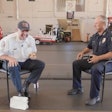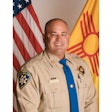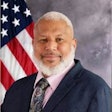In July 2012, a gunman entered a multi-screen movie theater in Aurora, CO, during a midnight screening of the film “The Dark Knight Rises” and opened fire on the moviegoers, killing 12 people and wounding or injuring 70 others.
After the evacuation of the wounded—many transported in police cars due to a lack of available ambulances for the volume of people in need of immediate medical care—the investigation began at what was one of the largest crime scenes in the history of Colorado.
Lieutenant Tim DuFour has served with the Aurora Police Department for 44 years. For the past three decades he has been in forensics, running the agency’s crime lab. He has seen thousands of crime scenes but none was like what he encountered when he arrived at the Century 16 Movie Theater less than an hour after the first calls to police started coming into 911.
Processing While Processing
DuFour says that his experience over many years of processing crime scenes helped him deal with the theater shooting forensics from a tactical, practical, emotional, and psychological standpoint.
“On any crime scene, I look at it as a job that needs to be done—I try not to empathize with the victim. I try not to get emotionally upset by the violence that I see and try to concentrate on the work that needs to be done,” DuFour says. “This was horrific. This had more victims than we’ve ever had before in any one setting, but I’ve seen a lot of single person homicides that just were atrocious and terrible to try to think about, to try to work through. So you need to be able to focus on what you’re doing and not focus on the carnage around you.”
Immediately after the incident, DuFour and his team of crime scene investigators began the process of collecting evidence and organizing it for delivery to the prosecutors who would be seeking to place the gunman in jail for the remainder of his life.
Making a Plan
“My first priority at that crime scene was to get to the victims and get them identified, so we could make notifications to the family,” DuFour said. “That took the entire first day.”
Then, the processing of the crime scene began in earnest with DuFour at the helm and a group of investigators working with him to methodically collect evidence to build the case against the gunman.
“We broke it down. We had team meetings and we came up with a plan on what we would do every day, and I made assignments to people and got them working on stuff. Then at the end of the day, we had a debriefing and figured out what we did that day and then what we had left to do the remainder of the time,” he says.
DuFour had two primary crime scene investigators at the site working with him and the Aurora Police Department had a lab staff of 10 at that time and every one of those individuals was involved in some part of the crime scene processing.
Coaching the Team
Aurora PD was the lead agency investigating the incident, and DuFour was one of the top people involved in the process, but there were myriad other agencies at the scene initially, and involved in the investigative process thereafter.
“I had a ton of mutual aid,” DuFour says. “By the time I got to the scene—and I was at the scene probably within 30 to 45 minutes of the incident going down—the mutual aid for police response was so heavy that the entire parking lot was filled with patrol cars, police cars, from all jurisdictions. I got into the scene and there was even a crime scene unit from the Denver Police Department that was already there and waiting to help if we needed the help.”
There were people from ATF, FBI, Denver Police, and other agencies present and eager to help Aurora PD in any way possible. DuFour did what anyone with his experience would do—he looked at the team assembled before him and deployed them to maximize their strengths.
“What I did was look at what I had to do—what kind of specific tasks were needed and what kind of specific specialties that I needed—and looked at who had that type of expertise and then allocated responsibilities and tasks based on that,” DuFour says.
Anyone who has ever coached a youth sports team knows that there are two basic rules for success—for the team, for the kids, and for the families. The first is to let the kids play. The second is to guide those players to do the things they’re best at doing.
So DuFour took full advantage of the team that had assembled itself in that parking lot, and asked each group to contribute what they could.
“Nobody tried to take over the scene. Everybody was there—federal, local, state—they said, ‘What do you need?’ Not, ‘This is how we’re going to do it.’ So I looked at who had that type of expertise and then allocated responsibilities and tasks based on that,” he explains.
High Tech and History
At the time of the theater shooting in Aurora, DuFour had on order a fairly new technology that allowed investigators to digitally capture the scene with 3D imaging.
“I had ordered one probably two weeks before this thing happened, but it was not in my possession and we were not trained on how to use it. The FBI had that capability. And so I asked the FBI if they could do that for us and they said, ‘Absolutely,’ and they brought a team out from the lab in Quantico and they did a 3D scan of the theater for us.”
DuFour says the 3D technology was helpful, but the basics of processing a scene have not really changed that much in decades.
“We find the evidence. We package it up. We mark it to identify it. Seal it up. Maintain chain of custody, and then turn it over to the scientists to do all of the analysis.”
He added, “Picking up something with a pair of tweezers is still picking up something with a pair of tweezers.”
Lessons Learned
DuFour says that the biggest lesson learned during the investigation was the need to consider the physical and emotional well-being of his team.
“We probably worked 15 hours a day, every day, for nine days, 10 days, something like that, and people in this business have a tendency not to take care of themselves,” DuFour says. “They are so focused on what they are doing. They don’t stop to think to take a break, to eat lunch, eat dinner, do whatever. They don’t think about the psychological impact that the scene is having on them, so the biggest thing that I had to think about—that I had never had to think about before—was taking care of my people. Taking care of their health needs, taking care of their psychological needs.”
DuFour also says that he learned that processing a scene as vast as the theaters, with that number of pieces of evidence, is daunting. But it’s doable as long as you have a great team in place.
“Before I even got into the crime scene, I had members of my lab staff calling and saying ‘We’re ready,’” DuFour says, adding that the quality of his team made a big difference.
Doug Wyllie is contributing web editor for POLICE. You can read his article on incident command at the Aurora theater shooting on PoliceMag.com.

















